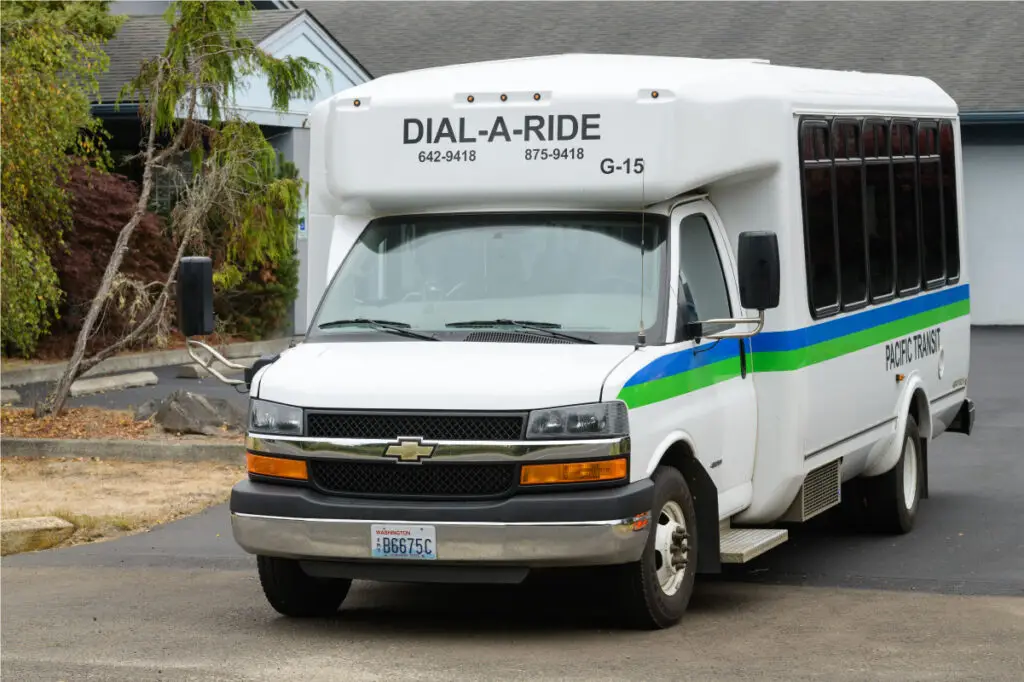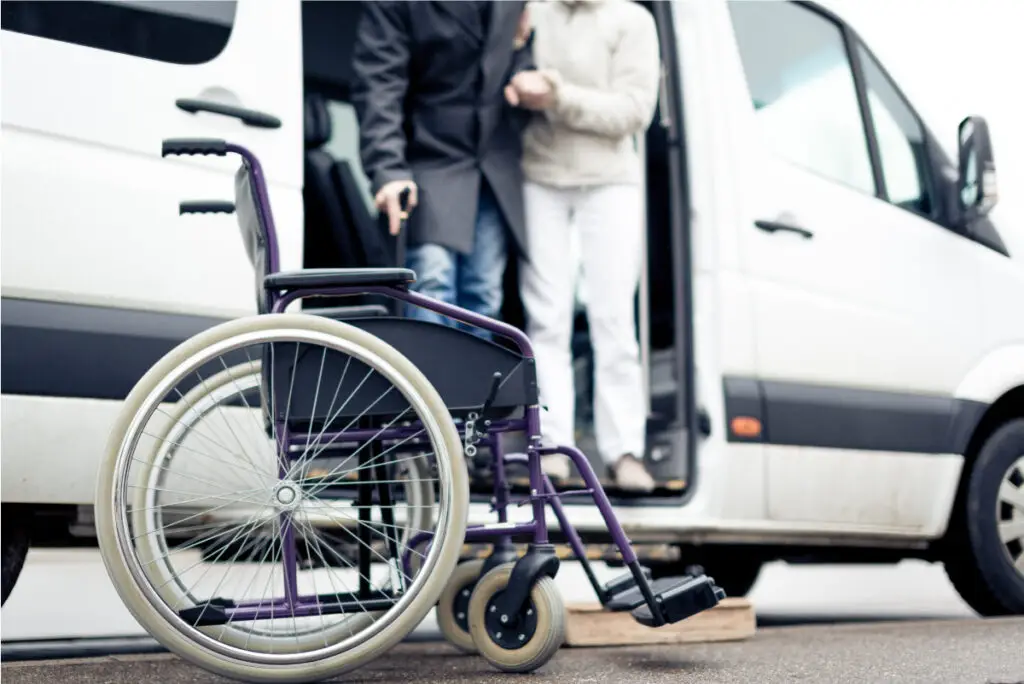February 26, 2024

Demand-responsive transport (DRT) is a type of shared transport for groups, including buses, which can alter the routes on demand rather than using fixed routes or timings. DRT can be used for non-emergency medical transport (NEMT) or standard trips outside scheduled transit agencies.
Demand-responsive transportation (DRT) encompasses various use cases tailored to meet diverse transportation needs. Some common types of DRT systems use cases include:
Catering to individuals with disabilities or special mobility needs, offering flexible and personalized transportation solutions.
Providing transportation solutions for students or school transport services, often tailored to specific schedules and destinations.
Offering on-demand transportation between cities or regions, providing flexible and convenient travel options for passengers.
Transporting passengers to predetermined locations such as medical facilities, shopping centers, or tourist attractions.
Operating during late hours to accommodate passengers requiring transportation during non-standard times, such as night shifts or social outings.
Serving the broader population with flexible transportation options, including trips without a predetermined destination or user segment, offering a versatile solution for various travel needs.
These use cases highlight the adaptability and versatility of demand-responsive transportation in addressing a wide range of transportation demands within communities and across different sectors.
The findings indicate that DRT initiatives may suffer from inadequate planning, particularly when the market and budget are not thoroughly grasped. There’s a risky inclination to incorporate excessively adaptable services and costly technologies even when they’re unnecessary, underscoring the importance of accurately predicting ridership demands and efficiently managing resources, ideally with automated systems in place.
Demand-responsive transit (DRT) exceeds the limitations of a fixed-route bus service or traditional public transport systems in terms of adaptability. It caters to the requirements of rural communities by offering a range of transport vehicle choices as feeder services to conventional bus services.

Demand-responsive transport (DRT), also called DRT Transit is a significant advancement in transportation systems, particularly in Europe, where its importance is critical in meeting citizens’ changing needs. The significance of DRT services in Europe stems from its ability to address several key transportation challenges:
Flexibility in Routing: DRT services provide flexible routing options that can adapt in real-time to demand and user data. DRT dynamically adjusts its routes to better serve passengers, reducing unnecessary detours and optimizing travel time. These intelligent transportation systems offer efficient community transport services.
Routing designs can be divided into four main designs:

Demand-response transportation (DRT) comprises vehicles like taxis, vans, or small buses, which are activated upon request from passengers or their representatives to the transit provider or existing services. DRT services offer a diverse array of vehicle options, ensuring they can cater to a wide range of transportation requirements. It’s noteworthy that DRT solutions often serve as an effective method for taxi companies to optimize fleet utilization and increase ride opportunities for drivers. This benefits both parties by ensuring vehicle availability, which is financially advantageous for drivers and taxi owners. Moreover, it enables companies to enhance service levels by improving vehicle availability.
While minibuses are commonly deployed, the inclusion of different vehicles underscores DRT’s adaptability, enabling the selection of the most suitable vehicle for each scenario, thereby enhancing overall efficiency. Upon receiving a request, the transit operator sends a vehicle to collect the passengers and take them to their desired locations.
This diverse selection ensures that DRT services can effectively meet the specific needs of its passengers while providing them with flexible transport services and the best possible transportation experience.
On-Demand Service:
DRT offers convenient and flexible on-demand transportation services, allowing passengers to request rides from their current location and be dropped off close to their desired destination. This differs from traditional DRT services, which typically operate at predetermined pick-up and drop-off locations. According to operator data, the most common trip patterns include distances of 5-10 kilometers (36%), and durations of 10-20 minutes (42%).
DRT uses digital platforms like mobile apps and online booking systems to improve communication between passengers and service providers. These platforms allow users to easily request rides, track vehicle locations in real-time, and provide feedback, resulting in a better overall user experience. Furthermore, the integration of demand-responsive routing software, such as TaxiBook IQ, optimizes routes based on passenger requests, ensuring efficient and timely demand-responsive transport. For example, the QoS (Quality of Service) view in TaxiBook IQ offers direct insights into service quality and key performance indicators (KPIs) that companies can utilize to optimize their operations. For instance, analyzing the availability of rides in the system versus on-time pickup accuracy can gauge fleet usage. By comparing these metrics across different days of the week and times, trends can be identified to inform shift planning. Modern systems like this assist companies by providing actionable insights on how to increase profitability.
DRT relies heavily on Data-Driven Operations, which use sophisticated analytics to improve service delivery. DRT anticipates changes in demand and makes real-time adjustments to its operations by analyzing historical travel patterns, traffic situations, and user preferences. This methodology enables DRT to optimize routes for complex routing, allocate resources more efficiently, and improve overall service quality, resulting in a transportation experience that is tailored to passengers’ needs and highly responsive to their requirements.
DRT significantly improves access to demand-responsive transport services, especially for those living in underserved areas or with limited mobility options. By providing dependable and efficient transportation, DRT services promote social inclusion and connectivity. This initiative ensures that people who face transportation barriers can overcome them and gain access to opportunities and resources. By bridging the transportation gap for those in need, DRT helps to create a more inclusive and connected society.

The integration of ride-sharing and micro-transit services is critical for expanding demand-responsive transport services in underserved communities. Individuals in underserved communities benefit from improved access to essential services such as employment, education, and healthcare when these services are integrated into Digital Demand-Responsive Transportation (DRT Services). This integration not only improves mobility but also promotes independence for those who may face transportation challenges, empowering them to overcome such barriers and live more fulfilling lives.
DRT services benefit the environment by promoting green vehicles such as electric, hybrid, and even self-driving cars. Integration with public transportation encourages the use of shared transportation options, thereby reducing congestion and emissions.
Leaving their private vehicles at home more often to ride with DRT can help reduce traffic congestion and carbon emissions on the road, as well as household transportation costs when the accumulated expenses of owning a vehicle are considered. These electric and hybrid vehicles use platforms like TaxiBook IQ to provide fuel-efficient routing, further reducing fuel consumption and emissions.
Overall, Demand-Responsive Transport (DRT Services) is undergoing a significant transformation as the technology with platforms like TaxiBook IQ leads the way, resulting in a mode of transportation that is not only safer and faster but also more environmentally friendly. This transformation improves the overall user experience and contributes to environmental sustainability. Continuous innovation in a variety of areas, including autonomous vehicles, the integration of renewable energy sources, and the use of data analytics promises even more significant improvements in the future.
Get your free demo now and see how our SaaS platforms will optimize your transportation organization.
Subscribe to our newsletter
2023. All rights reserved. DDS Wireless Inc.